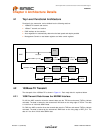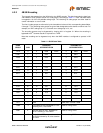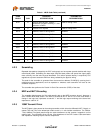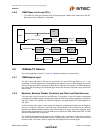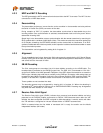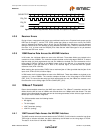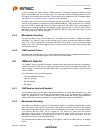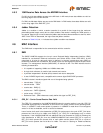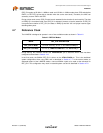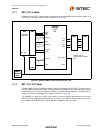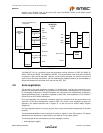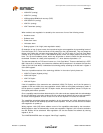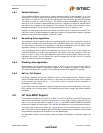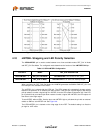
Small Footprint RMII 10/100 Ethernet Transceiver with HP Auto-MDIX Support
Datasheet
SMSC LAN8720/LAN8720i 25 Revision 1.0 (05-28-09)
DATASHEET
4.5.3 10M Receive Data Across the MII/RMII Interface
For MII, the 4 bit data nibbles are sent to the MII block. In MII mode, these data nibbles are valid on
the rising edge of the 2.5 MHz RXCLK.
For RMII, the 2bit data nibbles are sent to the RMII block. In RMII mode, these data nibbles are valid
on the rising edge of the RMII REF_CLK.
4.5.4 Jabber Detection
Jabber is a condition in which a station transmits for a period of time longer than the maximum
permissible packet length, usually due to a fault condition, that results in holding the TXEN input for a
long period. Special logic is used to detect the jabber state and abort the transmission to the line, within
45ms. Once TXEN is deasserted, the logic resets the jabber condition.
As shown in Ta bl e 5.22 , bit 1.1 indicates that a jabber condition was detected.
4.6 MAC Interface
The RMII block is responsible for the communication with the controller.
4.6.1 RMII
The SMSC LAN8720 supports the low pin count Reduced Media Independent Interface (RMII)
intended for use between Ethernet transceivers and Switch ASICs. Under IEEE 802.3, an MII
comprised of 16 pins for data and control is defined. In devices incorporating many MACs or
transceiver interfaces such as switches, the number of pins can add significant cost as the port counts
increase. The management interface (MDIO/MDC) is identical to MII. The RMII interface has the
following characteristics:
It is capable of supporting 10Mb/s and 100Mb/s data rates
A single clock reference is used for both transmit and receive.
It provides independent 2 bit wide (di-bit) transmit and receive data paths
It uses LVCMOS signal levels, compatible with common digital CMOS ASIC processes
The RMII includes 6 interface signals with one of the signals being optional:
transmit data - TXD[1:0]
transmit strobe - TXEN
receive data - RXD[1:0]
receive error - RXER (Optional)
carrier sense - CRS_DV
Reference Clock - (RMII references usually define this signal as REF_CLK)
4.6.1.1 CRS_DV - Carrier Sense/Receive Data Valid
The CRS_DV is asserted by the LAN8720/LAN8720i when the receive medium is non-idle. CRS_DV
is asserted asynchronously on detection of carrier due to the criteria relevant to the operating mode.
That is, in 10BASE-T mode, when squelch is passed or in 100BASE-X mode when 2 non-contiguous
zeroes in 10 bits are detected, carrier is said to be detected.
Loss of carrier shall result in the deassertion of CRS_DV synchronous to the cycle of REF_CLK which
presents the first di-bit of a nibble onto RXD[1:0] (i.e. CRS_DV is deasserted only on nibble
boundaries). If the LAN8720/LAN8720i has additional bits to be presented on RXD[1:0] following the
initial deassertion of CRS_DV, then the LAN8720/LAN8720i shall assert CRS_DV on cycles of
REF_CLK which present the second di-bit of each nibble and de-assert CRS_DV on cycles of
REF_CLK which present the first di-bit of a nibble. The result is: Starting on nibble boundaries




